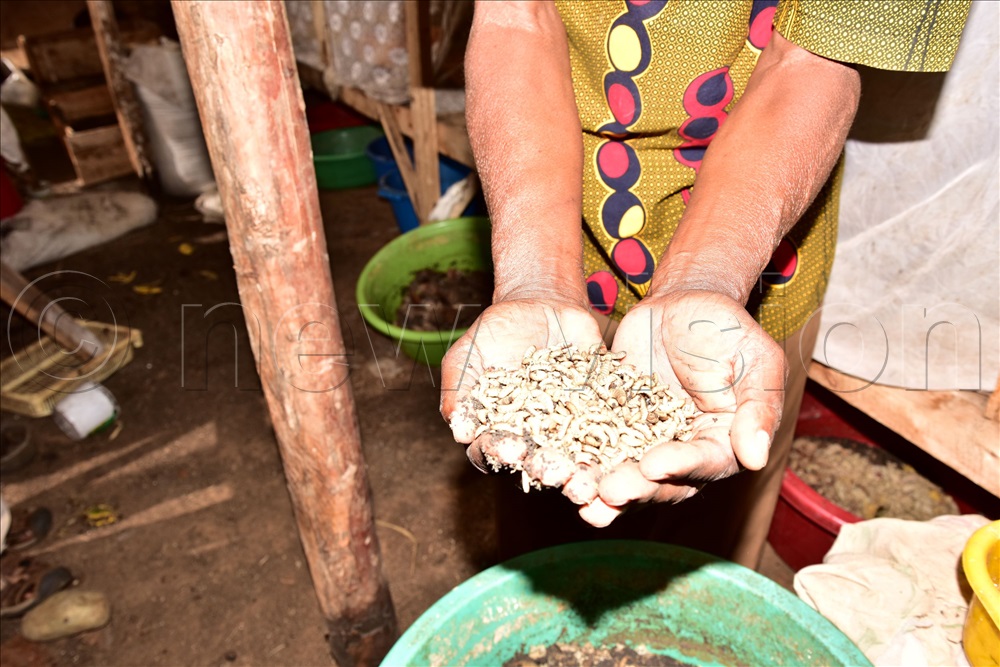By Umar Nsubuga
Francis Tinkasimiire is a renowned insect farmer in Kyabajwa Village, Central Ward Parish, Bunyangabu District.
He specializes in worm farming within a greenhouse, where temperature and conditions can be meticulously controlled.
Tinkasimiire explains that successful worm farming requires precise manipulation of conditions. The project begins with larvae, which go through five instar stages. The fifth instar is particularly important because it contains a higher concentration of nutrients.
During the larval stage, worms consume large quantities of food to accumulate the protein and fat necessary for their survival in the adult stage.
Tinkasimiire notes that this stage is crucial for building up reserves that will support the insect through adulthood.

In terms of nutritional value, the larvae contain 50 to 60 percent protein, which is higher than that found in fish meals. This makes them a valuable component in animal feed.
Egg production
Tinkasimiire’s egg production unit features larva cages equipped with dishes for larvae, pupae, and eggs. These cages also contain attractant dishes and water, as the insects do not consume food during this stage.
“An improvised incubator within the greenhouse maintains the necessary conditions for the eggs to hatch. Once the larvae reach the third instar, they are transferred to the main waste area, where they feed for about 15 days,” he says.
Larva production
He explains that the larva production unit, known as the lavarium, contains 100 basins. Each basin, after 15 days, can produce approximately 3 kilograms of larvae from 6 kilograms of waste. The waste is fully consumed and converted into organic matter.
After harvesting, he says the larvae are washed and dried.
Currently, Tinkasimiire uses traditional drying methods but plans to invest in a solar dryer or oven. The drying process takes 90 minutes with an oven, compared to longer durations with other methods.
“Dried larvae are then processed into powder for livestock feed and packaged for sale. One kilogram of dried larvae sells for sh10,000, though it takes about 3 kilograms of raw larvae to produce 1 kilogram of dried larvae,’ he states.
Challenges and opportunities
Tinkasimiire highlights that initial investments in equipment and infrastructure are substantial, and calculating profits can be challenging. However, with a consistent supply of waste and eggs, production can be maintained.
“The cost of pupae is sh40,000. After being placed in the larva cage, they transform into adults. These adults lay eggs, which are then transferred and kept at optimal temperatures to hatch,” he explains adding that the younger larvae are fed organic waste, including fruits and vegetable peelings.
One major challenge is the lack of a machine to crush waste into smaller pieces. However, decomposable materials can be used effectively as feed.
Black Soldier Flies
Black soldier flies are raised in the lave cage, which contains various elements to facilitate egg production. Sticks are placed in the cage where the flies lay their eggs.
According to expert Felix Bagonza, these sticks and attractants are crucial as they help the flies lay eggs where food is available for the larvae.
A single black soldier fly can lay around 1,000 eggs before dying. The entire life cycle—from egg to adult—lasts between 5 to 10 days. After laying eggs, both the male and female flies die shortly thereafter.
Initially, Tinkasimiire purchased pupae from Kampala at a cost of sh40,000 per kilogram.





